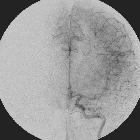Corpus callosum




The corpus callosum (plural: corpora callosa) is the largest of the commissural fibers, linking the cerebral cortex of the left and right cerebral hemispheres. It is the largest white matter tract in the brain.
Summary
- located inferior to the cerebral cortices, and superior to the thalamus
- connects left and right cerebral hemispheres
- majority of vascular supply from the pericallosal arteries
Gross anatomy
The corpus callosum is approximately 10 cm in length and is C-shaped (like most supratentorial structures) in a gentle upwardly convex arch. It is thicker posteriorly.
It is divided into four parts (from anterior to posterior):
- rostrum
- thicker beaked segment
- thinner lamina rostralis (continuous with the lamina terminalis)
- genu
- trunk/body
- splenium
Relations
Immediately above the body of the corpus callosum, lies the interhemispheric fissure in which runs the falx cerebri and branches of the anterior cerebral vessels. The superior surface of the corpus callosum is covered by a thin layer of grey matter known as the indusium griseum.
On either side, the body is separated from the cingulate gyrus by the callosal sulcus.
Attached to the concave undersurface of the corpus callosum is the thin vertical septum pellucidum anteriorly, and the fornix and its commissure posteriorly.
Fiber tracts
Although the corpus callosum can be seen as a single large fiber bundle connecting the two hemispheres, a number of individual fiber tracts can be identified. These include:
- genu: forceps minor connects medial and lateral surfaces of the frontal lobes
- rostrum: connecting the orbital surfaces of the frontal lobes
- trunk (body): pass through the corona radiata to the surfaces of the hemispheres
- trunk and splenium: tapetum; extends along the lateral surface of the occipital and temporal horns of the lateral ventricle
- splenium: forceps major; connect the occipital lobes
These connections can also be divided into:
- homotopic connections: those that link similar regions on each side (e.g. visual fields of motor/sensory areas of the trunk)
- heterotopic connections: those that link dysimilar areas
Arterial supply
The corpus callosum (CC) has a rich blood supply, relatively constant and is uncommonly involved by infarcts. The majority of the CC is supplied by the pericallosal arteries (the small branches and accompanying veins forming the pericallosal moustache) and the posterior pericallosal arteries, branches from the anterior and posterior cerebral respectively. In 80% of patients, additional supply comes from the anterior communicating artery, via either the subcallosal artery or median callosal artery.
- subcallosal artery (50% of patients) is essentially a large version of a hypothalamic branch, which in addition to supplying part of the hypothalamus also supplies the medial portions of the rostrum and genu
- median callosal artery (30% of patients) can be thought of as a more extended version of the subcallosal artery, in that it travels along the same course, supplies the same structures but additionally reaches the body of the corpus callosum
- posterior pericallosal artery (also known as the splenial artery) supplies a variable portion of the splenium. Its origin is inconstant, arising from P3 or branches thereof
Development
The development of the corpus callosum occurs between the 12 and 16-20 weeks of gestation . It begins with the anterior body and then continues bidirectionally, with the anterior portions (genu) developing earlier/more prominently than the posterior portions (splenium) .
Myelination of the corpus callosum occurs in the opposite direction, from the splenium forwards.
Variant anatomy
History and etymology
From the Latin, corpus meaning "body" and callosum, "hard" or "tough".
Siehe auch:
- Balkenläsionen
- Arteria pericallosa
- forceps major
- pericallosal moustache
- forceps minor
- indusium griseum
- Corona radiata (ZNS)
und weiter:
- Arteria cerebri anterior
- callososeptal interface
- Normaldruckhydrozephalus
- Liquorunterdrucksyndrom
- Encephalomyelitis disseminata
- Cisterna quadrigeminalis
- velum interpositum
- Glandula pinealis
- arterielle Versorgungsgebiete des Gehirns
- venus necklace
- Verschlusshydrocephalus
- ambient cistern
- diencephalon
- zerebrale Radionekrose
- Subakute sklerosierende Panenzephalitis
- Vena cerebri magna
- Tumor im Corpus callosum
- classification system for midline abnormalities of the brain and skull
- paediatric curriculum
- commissures of the brain
- probst bundles
- communicating obstructive hydrocephalus
- Alien-Hand-Syndrom
- sub acute sclerosing panencephalitis
- Hydrocephalus communicans

 Assoziationen und Differentialdiagnosen zu Corpus callosum:
Assoziationen und Differentialdiagnosen zu Corpus callosum:



